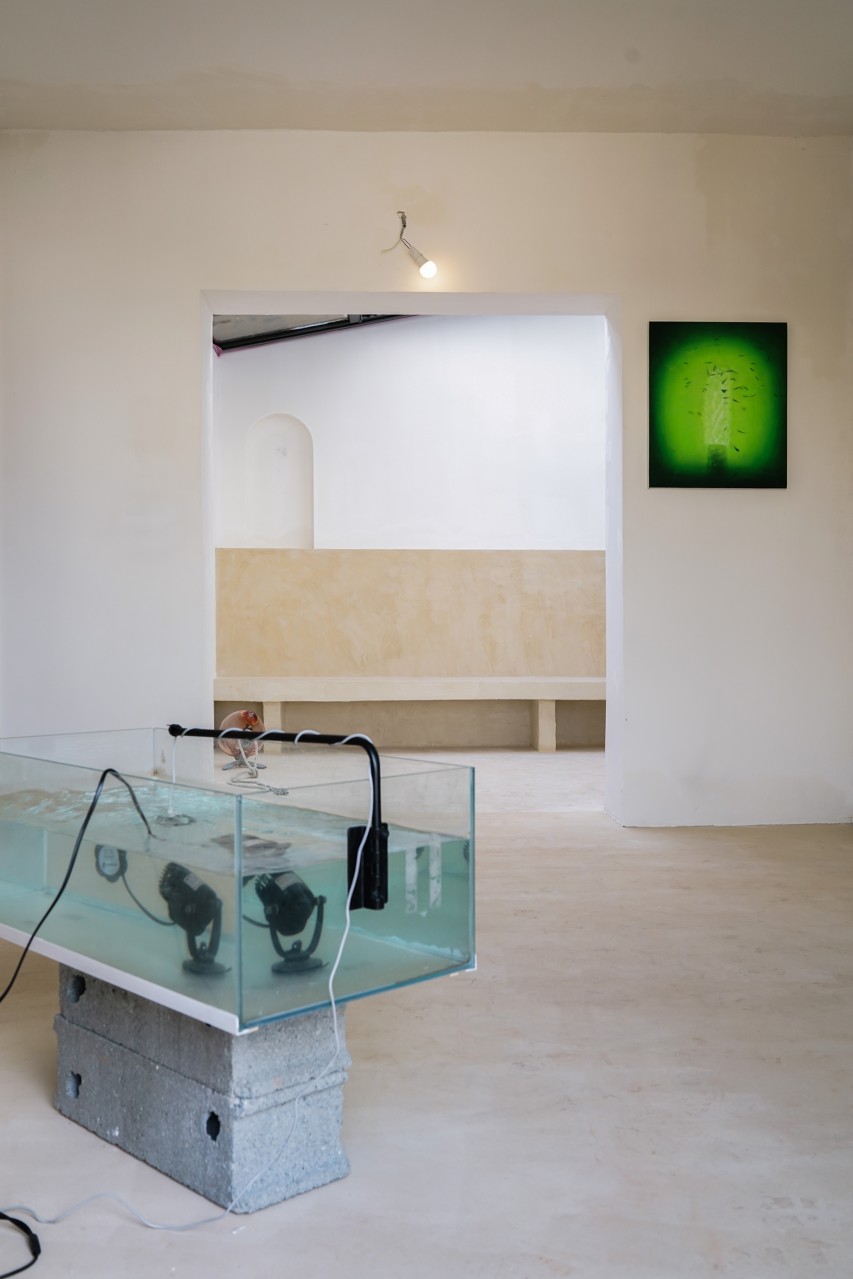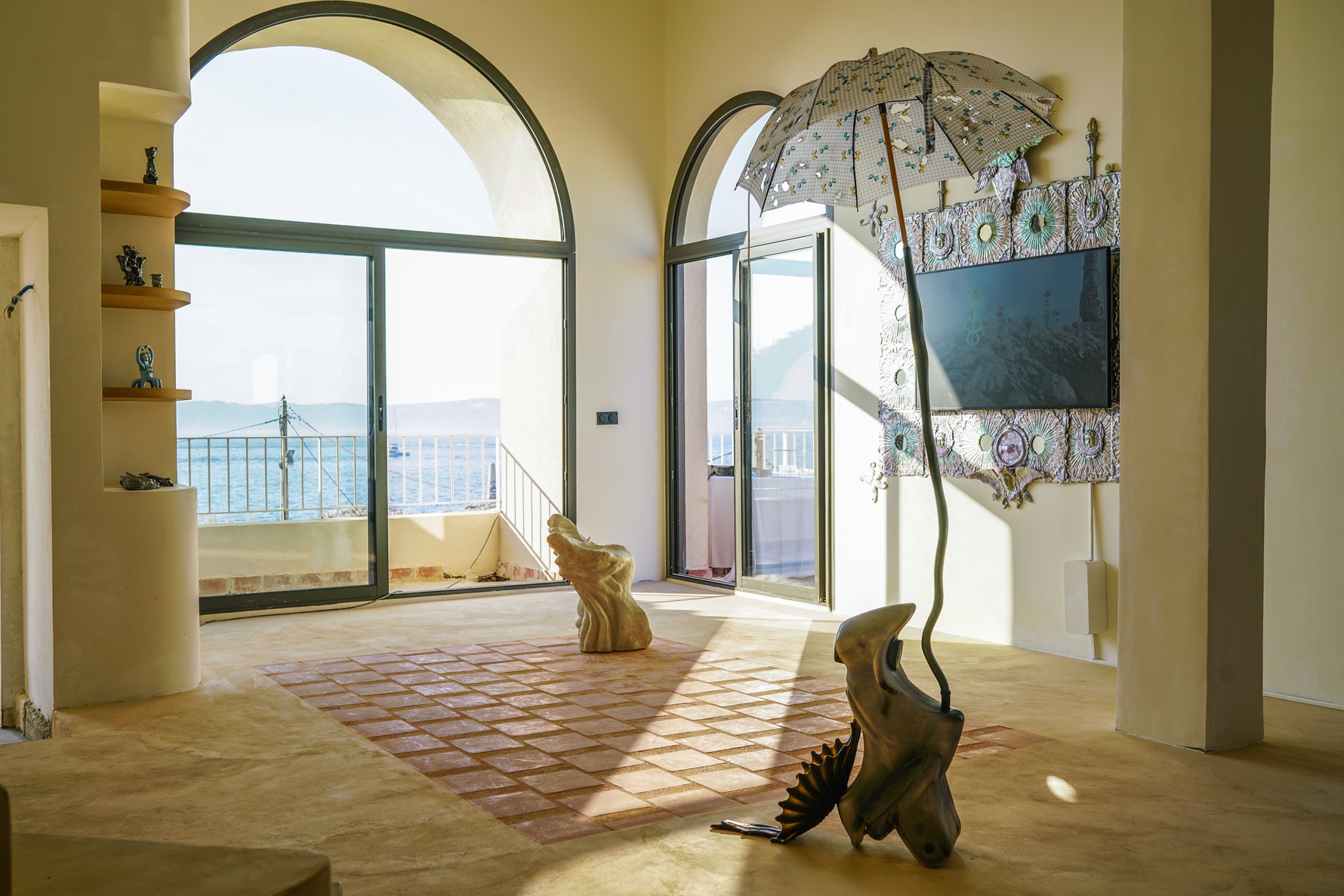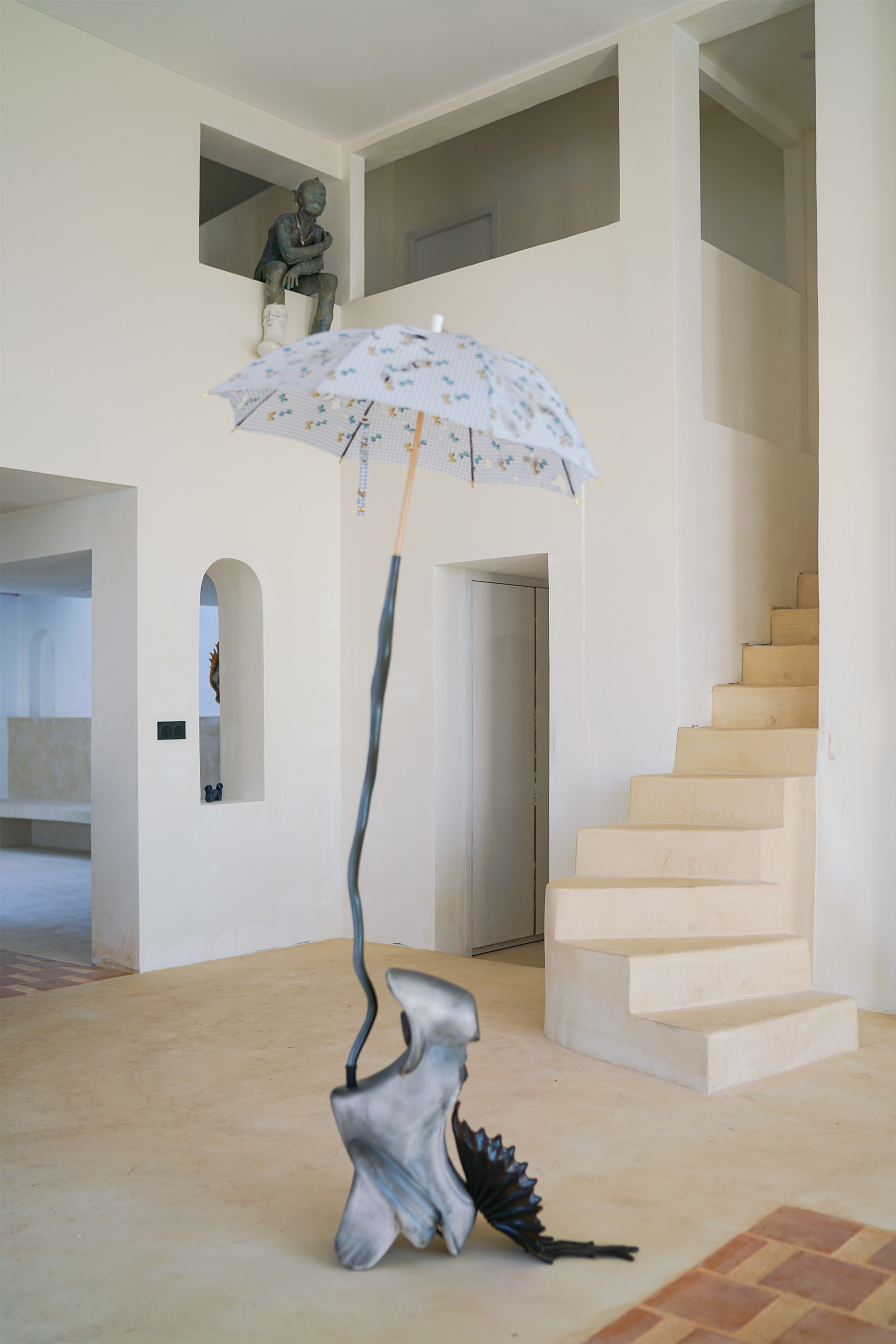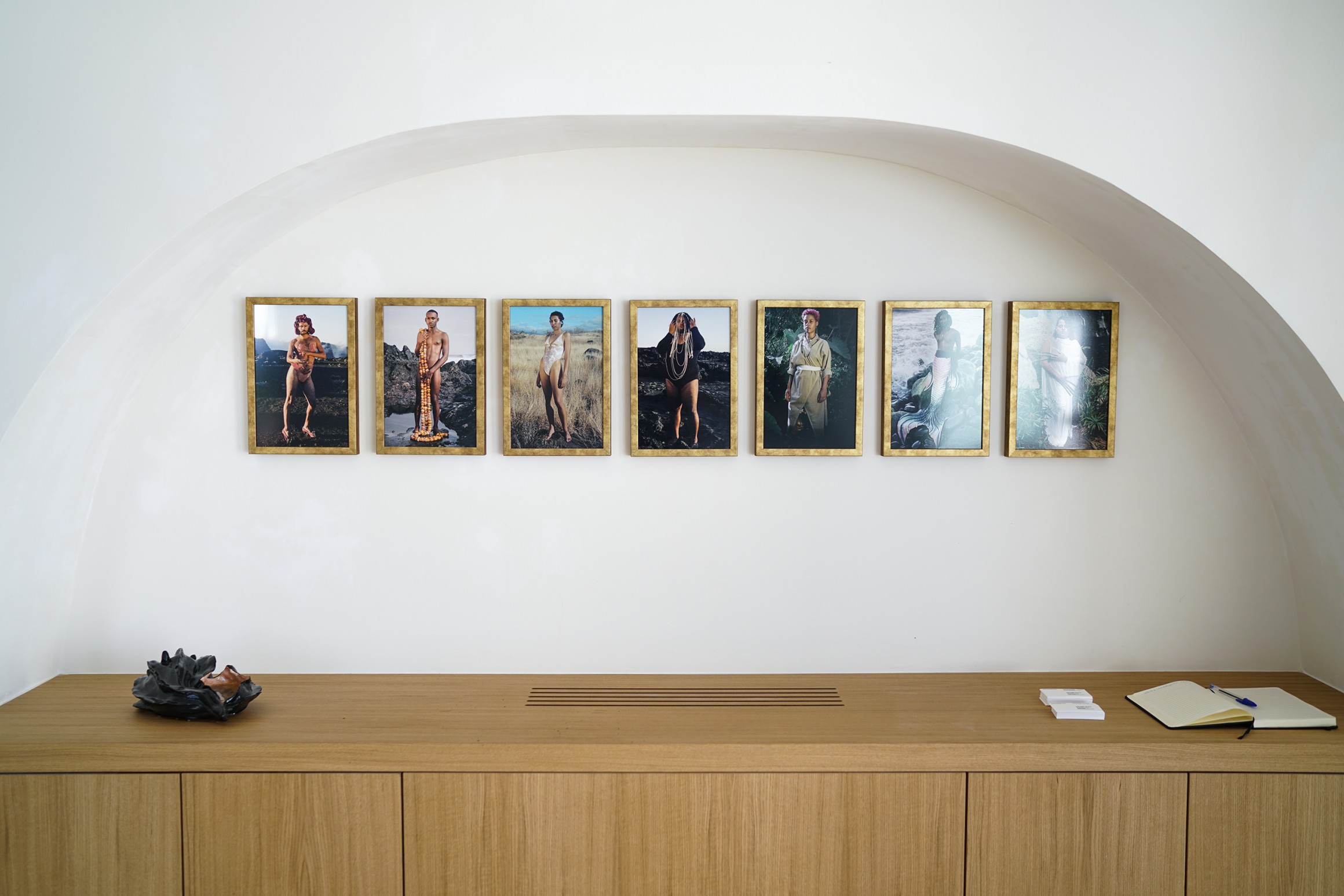
- Ánima Correa
- Antoine Donzeaud
- Marilou Poncin
- Valentin Ranger
- Chloé Royer
- Jack Warne
- Romana Londi
- Odyssea : Acte I : Claire Bouffay - Nina Boughanim - Sol Cattino - Bella Hunt & DDC - Michele Gabriele - Charlotte Gautier Van Tour & Jimmy Boury - Brandon Gercara & Ugo Woatzi - Laura Gozlan - Jean-Baptiste Janisset - Hyewon Mia Lee - Opale Mirman - Carole Mousset - Talita Otovic
Odyssea - Acte I : Le chant des sirènes

Exhibition view, Odyssea. Act I : Le chant des sirènes, LA PLAGE, Marseille, 2024. Photo © Gregg Bréhin
We are all chimeras, beings in perpetual mutation, shaped by the invisible currents of time and culture. The mermaid, a mythical figure half-female, half-fish, becomes a contemporary symbol of our constantly changing society. She embodies this hybridity, this mixture of forms and identities, a reflection of our own inner and outer metamorphoses.
First, let’s delve into the enigmatic world of mermaids. These mythical creatures, born of the maritime legends of different cultures, represent much more than a simple myth. They mirror our fascination for the unknown, for this infinite ocean; the only territory still partly unexplored today, which like our lives, conceals unfathomable mysteries. Ancestral tales and artistic representations of mermaids invite us to immerse ourselves deeply in this marine universe, where the line between reality and legend is blurred. Works by Nina Boughanim, Charlotte Gauthier van Tour & Jimmy Boury, Claire Bouffay, Bella Hunt & DDC, Opale Mirman, Laura Golzan, Carole Mousset and Ánima Correa reveal the depths of this inhabited underwater ecosystem, populated by mythological creatures and enchanting landscapes. Each artist, in his or her own way, explores this universe that is both fascinating and terrifying, reminding us that the mystery in each of us is as vast as the ocean itself. Their creations transport us into a world where poetry and terror mingle, inviting the viewer to take an introspective plunge into the abyss of the human soul.

Exhibition view, Odyssea. Acte I : Le chant des sirènes, LA PLAGE, Marseille, 2024. Photo © Gregg Bréhin

Exhibition view, Odyssea. Acte I : Le chant des sirènes, LA PLAGE, Marseille, 2024. Photo © Gregg Bréhin
The mermaid is revealed in a different light, as a seductive and dangerous woman. For centuries, tales of mermaids have embodied the fears and fantasies of patriarchal societies, where powerful, elusive femininity was perceived as a threat. These creatures symbolised irresistible temptation, capable of leading men to their doom and diverting them from their senses. The image of the mermaid as femme fatale reflects the way in which patriarchal society has long reduced women to objects of desire, demonising those who dared to break free from imposed roles.
The works of art that explore this facet of the mermaid highlight this duality: enchanting beauty on the one hand, and the trap of seduction on the other. They remind us that this mythological figure has been used to justify mistrust of free and independent femininity. Yet beneath this appearance of threat lies a subtle critique of patriarchal control; of the way in which women have been constructed as both desirable and threatening, precisely because they possess a strength that men cannot control. It is this tension between power and oppression that makes the mermaid such a complex and fascinating symbol, a figure both feared and admired.

Exhibition view, Odyssea. Acte I : Le chant des sirènes, LA PLAGE, Marseille, 2024. Photo © Gregg Bréhin

Exhibition view, Odyssea. Acte I : Le chant des sirènes, LA PLAGE, Marseille, 2024. Photo © Gregg Bréhin

Exhibition view, Odyssea. Acte I : Le chant des sirènes, LA PLAGE, Marseille, 2024. Photo © Gregg Bréhin
Then the mermaid emerges from the waters, no longer as the temptress of ancient tales, but as a figure of rebellion and emancipation. She symbolises a break with obsolete norms, a metamorphosis towards a new identity, freer and bolder. Historically, the mermaid has been perceived as an evil being, capable of seduction and destruction. Today, she has become a feminist icon, a powerful voice for the oppressed and marginalised. The works of Sol Cattino, Marilou Poncin and Hyewon Mia Lee perfectly embody this transformation. Through their creations, these artists reinterpret the myth of the mermaid, presenting her not simply as an object of fascination, but as a symbol of resistance against patriarchal and social oppression. These works testify to the power of the mermaid, her ability to rise above stereotypes to become an emblematic figure in the struggle for autonomy and equality. Poseidon may well remain at the bottom of the sea, a silent witness to a changing world, where once-stifled voices are now bursting forth with strength and determination.

Exhibition view, Odyssea. Acte I : Le chant des sirènes, LA PLAGE, Marseille, 2024. Photo © Gregg Bréhin

Exhibition view, Odyssea. Acte I : Le chant des sirènes, LA PLAGE, Marseille, 2024. Photo © Gregg Bréhin

Exhibition view, Odyssea. Acte I : Le chant des sirènes, LA PLAGE, Marseille, 2024. Photo © Gregg Bréhin
Finally, the journey ends with a reflection on fluidity and metamorphosis, intrinsic characteristics of mermaids. They transcend forms and identities, illustrating the human capacity to constantly evolve. This final chapter explores the notion of evolution and transition, emphasising that nothing is static. The works of Brandon Gercara & Ugo Waotzi, Jean-Baptiste Janisset, Laura Gozlan, Michele Gabriele and Talita Otović powerfully embody this idea. Through their creations, each of these artists explores the themes of transition, diversity and fluid identity, using the mermaid as a metaphor for mutation and adaptability. Their works invite us to embrace the multiplicity of identities and celebrate ongoing transformation. Through this artistic exploration, viewers are led to reflect on their own metamorphoses, on how we are all beings in the making, capable of adapting and redefining our identities in a constantly changing world.

Exhibition view, Odyssea. Acte I : Le chant des sirènes, LA PLAGE, Marseille, 2024. Photo © Gregg Bréhin

Exhibition view, Odyssea. Acte I : Le chant des sirènes, LA PLAGE, Marseille, 2024. Photo © Gregg Bréhin
In this way, the mermaid, an emblematic figure of marine legends, becomes a powerful symbol of our times, embodying the complexity of human identity and the beauty of transformation. She reminds us that, like her, we are all hybrid beings in search of meaning. Like mermaids, we are creatures of many voices, navigating the tumultuous waters of our contemporary ecosystems.
In Act II, entitled ‘The Salt of the Sea’, the Spiaggia Libera gallery will be extending this phantasmagorical epic in its Paris venue. In this second edition of Odyssea, a nebulous, post-humanist and post-capitalist universe takes shape, in which mermaids become futuristic figures and the earth’s rubble gives way to new forms of life.










